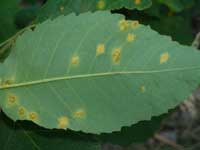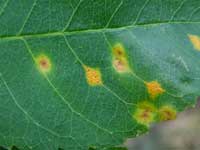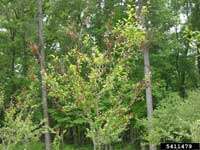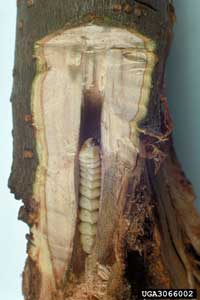Extension > Garden > Diagnose a problem > What's wrong with my plant? > Deciduous > Hawthorn > Dead twigs or branches
Hawthorn > Trunk/branches > Dead twigs or branches
1 of 3
Quince rust
Gymnosporangium clavipes
- Fruit and stems may be swollen or distorted
- Some yellow to orange leaf spots may be present
- Tubular, white fungal spore producing structures protrude from fruit, giving it a spiky appearance; become orange when spores are released
- Bright orange powdery spores may be seen on and around infected leaves and fruit
- More information on Quince Rust
2 of 3
Fire blight
Erwinia amylovora
- Infected leaves wilt, turn gray then dark brown to black
- Young shoots curl over into a shepherd's crook
- Infected blossoms first turn gray, then black
- Infected leaves and mummified fruit remain attached to the tree, often into winter
- Branch cankers have dark, sunken and cracked bark, sapwood is streaked reddish brown
- Drops of sticky honey-colored liquid can be seen on infected plant parts in warm wet weather
- More information on fire blight
3 of 3
Roundheaded appletree borer
Saperda candida
- Dead stems and stem breakage
- Cracks or splits in bark on lower stems
- Areas of darkened bark and sap oozing from entrance hole
- Larvae tan to cream colored and grub-like, about 1 – 1 ½" long
- Adult brown with two white stripes, about ¾" long with equally long antennae
- More information on Roundheaded appletree borer











